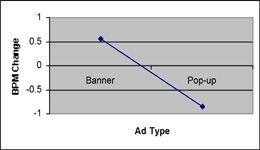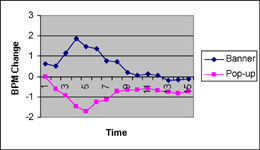Media Effects Research Lab - Research Archive
Psychological effects of pop-up windows and animation in web advertising
Student Researcher(s)
FangFang Diao (Masters Candidate);
Faculty Supervisor
FOR A COMPLETE REPORT OF THIS RESEARCH, SEE:
Diao, F., & Sundar, S. S. (2002, July). Orienting response and memory for Web advertisement: Exploring effects of pop-up window and animationPaper to be presented at the 52nd annual conference of the International Communication Association (ICA), Seoul, Korea.
INTRODUCTION
This study investigated the direct and combined effects of one structural feature (animation) and one formal feature (pop-up window) on online users' orienting response and memory for Web advertisements. Industry analysts have widely speculated that pop-up ads are enormously effective in attracting user attention, but so far there is little, if any, public empirical research concerning the effectiveness of pop-up ads. Especially, there is lack of empirical research pertaining to the potential effect of a pop-up window in conjunction with the presence of banner ads on the same Web page, even though both banner ads and pop-up ads coexist on a large number of portal Web sites. The present study examines the direct and combined effects of one structural feature (animation) and one formal feature (pop-up window) on online users' attention to Web ads, as indicated by orienting response (OR) and memory.
HYPOTHESES
H1a: Individuals will exhibit orienting responses with the sudden onset of pop-up windows.
H1b: Individuals will exhibit stronger orienting responses with the sudden onset of pop-up windows than with the onset of banner ads.
H2: Individuals who view animated ads will exhibit stronger orienting responses than those who view static ads.
H3: The animation effect on orienting responses will be stronger for pop-up than for banner ads.
H4a: The score for ad recognition will be highest when both pop-up ads and banner ads are animated, will be lowest when pop-up ads and banner ads are both static, and will be in-between when pop-up ads and banner ads are not of the same ilk.
H4b: The score for ad recall will be lowest when both pop-up ads and banner ads are animated, will be highest when pop-up ads and banner ads are both static, and will be in-between when pop-up ads and banner ads are not of the same ilk.
H5a: Ad recognition for pop-up ads will be higher than for banner ads.
H5b: Ad recall for pop-up ads will be lower than for banner ads.
METHOD
To examine the direct and combined effects of animation and pop-up window on online users' orienting responses and memory of Web advertisements, a 4x2x4x15 mixed-design factorial experiment was conducted, with animation condition as a between-participants variable and type of Web advertisement (banner ad vs. pop-up ad) as a within-participants variable. In this study, four versions of presentation of animation were used: AA -- animated banner ad + animated pop-up ad; AS -- animated banner ad + static pop-up ad; SA -- static banner ad + animated pop-up ad; SS -- static banner ad + static pop-up ad. The first independent variable, animation condition, then had four levels: AA, AS, SA, SS. The second independent variable, ad type, had two levels: banner ad or pop-up ad. To increase the generalizability of our findings, each participant (N = 50) was exposed to four different Web sites, each with a banner and a pop-up ad. The third independent variable, site ID, had four levels: site A, site B, site C, and site D. The fourth independent variable, time, had 15 levels, ranging from second 1 to second 15.
There were two dependent variables: orienting response and ad memory. Orienting response was monitored via heart-rate measures throughout the test period while ad memory was measured by means of a post-experiment paper-and-pencil questionnaire.
RESULTS
H1a: Supported. The occurrence of orienting response with the onset of pop-up windows was statistically significant.

H1b: Supported. Individuals exhibited stronger orienting responses with the sudden onset of pop-up windows than with the onset of banner ads.

H2: Not supported. Individuals who viewed animated ads did not exhibit stronger orienting responses than those who view static ads.
H3: Not supported. The animation effect on orienting responses was not stronger for pop-up than for banner ads.
H4a & H4b: Not supported. No main effect for animation condition on either ad recognition or ad recall was found.
H5a: Not supported. Ad recognition for banner ads were higher than for pop-up ads.
H5b: Not supported. Ad recall for pop-up ads was higher than for banner ads.
Although not hypothesized, there were some interesting interaction effects.
Two-Way Interactions
A significant interaction effect was found between ad type and time.

A near-significant interaction effect was found between animation condition and ad type.
A two-way interaction effect was found for animation condition and site ID on BPM change.
Three-Way Interactions
There were two three-way interaction effects in this study. A three-way interaction effect was found for animation condition, site ID, and ad type. This three-way interaction indicates that different combinations of presentation features and message content can have great impact on eliciting physiological changes. Somewhat the same conclusion was drawn from examining the other significant three-way interaction effect between animation condition, site ID, and time.
Four-Way Interaction
Surprisingly, there was a four-way interaction effect for BPM change, suggesting that, depending on the sites, the combination effect of ad type, animation condition, and time vary. Therefore, site content appears to be a pivotal determinant of OR.
CONCLUSION
Data analyses revealed a significant impact of pop-up window on orienting responses. The animation effect on orienting response was more complex than expected. Message content played an important role in eliciting orienting responses as demonstrated in various interaction effects. A main effect for animation condition on ad memory did not emerge. A main effect for ad type on ad memory was detected, but the direction of the means disconfirmed hypothesized expectations.
For more details regarding the study contact
Dr. S. Shyam Sundar by e-mail at sss12@psu.edu or by telephone at (814) 865-2173

